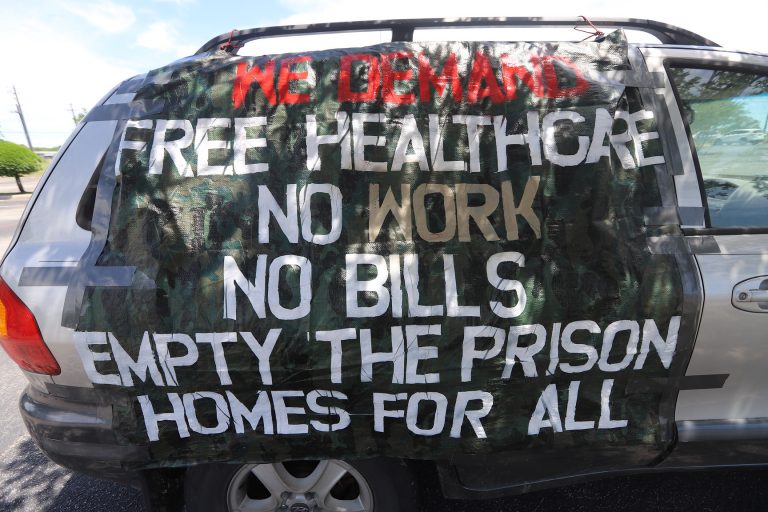Filed under: Analysis, Anarchist Movement, Central, Featured, Housing
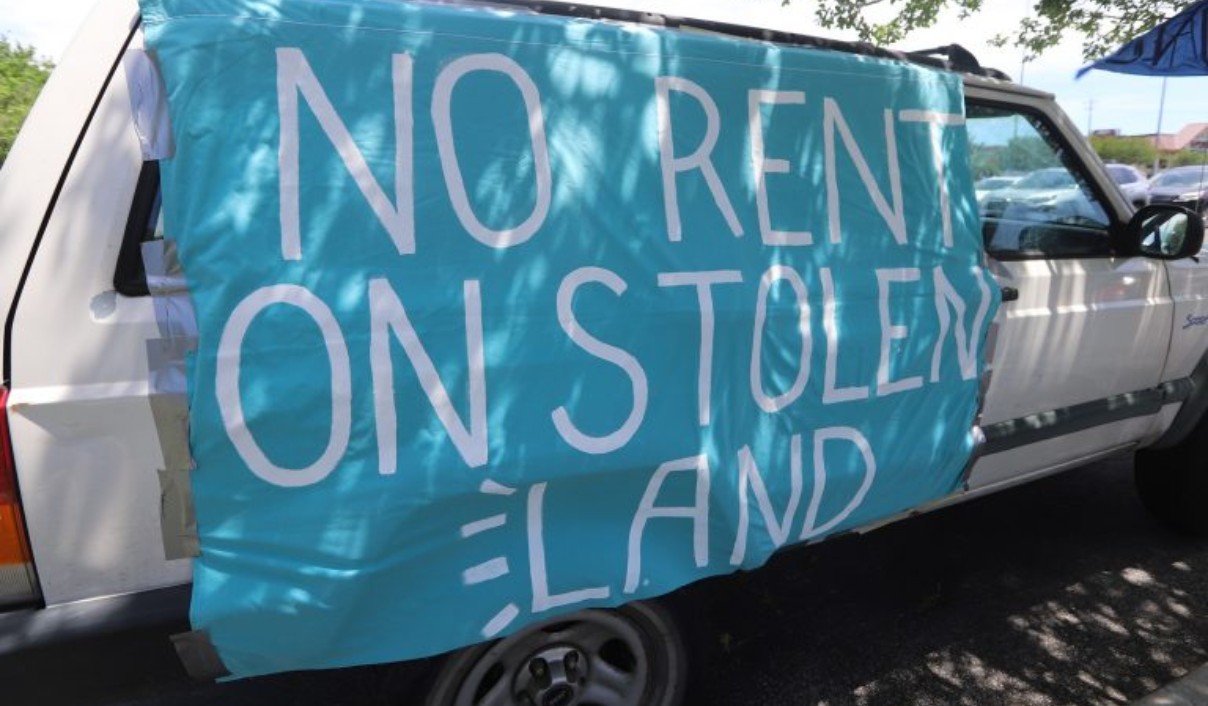
Report on May Day car caravan in Austin, TX and how it as repressed by local police.
On May 1st, a caravan of around 30 cars proceeded down I-35 as part of a May Day car demonstration hosted by Rent Strike ATX. Some cars bore banners and signs reading “Rent Strike,” and “Justice for Mike Ramos,” while others amplified various parts of the 5 demands which have been popularized nationwide (including free healthcare, freedom for prisoners, no debt, and homes for all).
This communique offers a participant’s perspective on the events of this May Day demonstration—both evaluating its local significance and the contribution it makes to evolving national experimentation with the car demo form. It is a response and extension of the strategic conversation initiated by friends in Atlanta around the car demo form, with analysis that still speaks deeply to a local context. This piece aims to cultivate, deepen, and inspire forms of autonomous action that can strike directly at the settler-colonial economic system which, with each passing day, reveals itself more and more to be a death cult for many of us. May the experience of this demonstration offer strategic clarity to others seeking ways to intervene in our exceptional moment, whether in so-called Austin or anywhere else across this world.
Snapshots of an Action
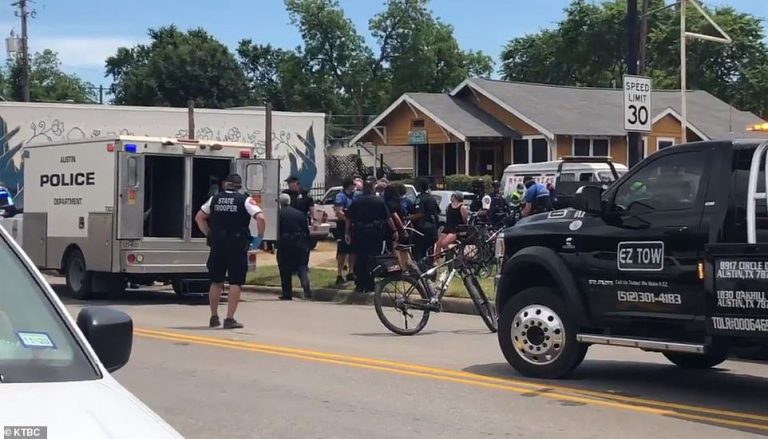
On the morning of May 1st, the caravan convened in a large parking lot. The assembled crowd was a ragtag crew composed of a range of age groups, occupations, and experience as “activists.” Those present had largely been assembled through direct relationships—networks of affinity, organizational relationships, and trust which had been built in the prior months. The location and details of the action had been elusive, with only a handful of people having been given the details without having some prior connection to Rent Strike ATX or their milieu.
After the organizers ensured everyone was up to date on the logistics of the action, the participants entered their cars and joined a collective zoom call used for communication and coordination. The organizers directed the cars to line up—with a set of designated guard cars taking up the front and rear in order to help keep the caravan tight and secure. Slowly, the caravan progressed onto the streets, wheres its long, serpentine form could barely be contained on the length of some of the streets traversed. Pretty quickly, the caravan reached the main section of I-35 downtown, where horns and cheers filled the air as the procession carried its message through the heart of the city.
This piece will not speak to what precisely happened to cause this or who the responsible party was, but we will note the effect: traffic along I-35 backed up massively. According to one participant, real time google maps data indicated that the back up extended as far as the outer suburb of Pflugerville. At this time, APD cars had parked in front of the caravan and cut off the path down the highway. After talking with multiple drivers and taking licenses and registration, they ordered the cars to all drive off the highway or face arrest. At this point, the demonstration had been on I-35 for perhaps 20-30 minutes.
Once the cars began moving off the highway, a battalion of State Troopers began blocking off roads and directing all the cars. All the vehicles were directed into a private parking lot. Soon, APD and State Troopers swarmed the lot and began their arrests. They targeted many drivers, though seemed to let some go arbitrarily. Other passengers were arrested, many charged with criminal trespassing. Some drivers had their cars towed even if they were not arrested. As this went down, a small crowd of supporters and passerby assembled to witness and document the arrests.
In all, the action itself probably lasted an hour, followed by an hour for the entire process of arrests and impoundings to go down. However, I-35 remained shut down for about two hours (estimating based off the timing of APD tweets) due to the incompetence of the police response, which continued to block the highway as they closed off roads and attempted to remove the caravan from the road. Additionally, their efforts disrupted traffic on the north bound frontage road, slowing down traffic in both directions on I-35 in the heart of downtown.
Attacking the Arteries
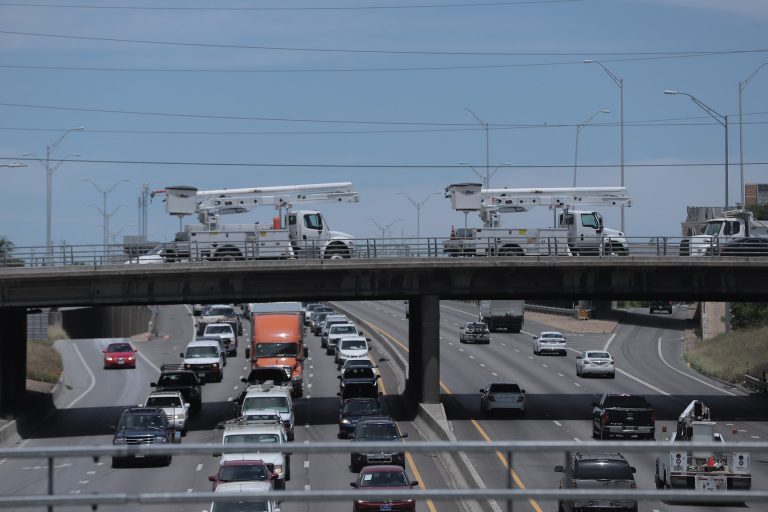
I-35 is not an incidental target in so-called Austin. It is the most visible of the city’s highways, passing right by Downtown. Within the city, it is the primary highway along which commuters and commodities both travel. Until recent waves of gentrification which have swept East Austin, the highway served as the de-facto barrier segregating the city along racial lines. Now, the same working classes—largely Black, Latinx, and immigrant—that I-35 separated find themselves traveling long commutes from the suburbs on the peripheries of the city, where they have been pushed by the rapid rise in rents and redevelopment of old neighborhoods to serve incoming professional classes.
At the city, national, and global level it is a vital part of the circulatory system of capital that feeds settler-colonialism on this land. The highway—which extends South to Laredo and North all the way to Minnesota, near the Canadian border—is a central conduit for trade between the US, Mexico, and Canada as part of the NAFTA partnership. The section of I-35 running through Downtown is the 10th largest Freeway Chokepoint in the country. It is not just local traffic passing through, but economic activity from the US Heartland and even from Canada.
Through this scar that settler civilization has imparted on the land, millions of dollars worth of commodities and laborers move, sustaining the flows of local and transnational exploitation, dispossession, and colonial wealth transfers. Since its inception, the highway has acted as a physical barrier manifesting race/class lines in the city, and continuing to provide space and resources for the the colonial infrastructure to continue its existence on stolen land. As symbol and as structure, I-35 lies at the nexus point of the forces which occupy, exploit, and dispossess this land, its ecosystems, and its peoples. Thus, actions which target this highway—regardless of their own intentionality—strike materially and symbolically at an entire social order.
It is in this context that I-35 takeovers remain significant yet rare. The highway is also significant to recent histories of revolt in the city. In September 2015, a Black Lives Matter demonstration briefly took I-35. Coming amidst a wave of highway takeovers by Black Lives Matter and anti-police demonstrations across the country, this bold action was met with similar police repression. Previous attempts to take I-35 had also been met with various efforts at counter-insurgency, from the cops intimidating protestors into staying off the highway, to exploiting the risk-aversion of some leftist organizers to discourage bold and confrontational tactics. The city has a vested economic and political interest in ensuring that protests, even if they are allowed to take the streets without a permit, do not seize I-35.
This context offers explanation to the evident rage and confusion of APD as they dealt with the protestors. Despite the caravan having exited the highway, they could not allow an action that bold, strategic, and inspiring to go unpunished. The strategy of mass arrest was not a response to any public safety threat, perceived or real, but an attempt to intimidate the Rent Strike protestors and anybody watching, to discourage forms of activity which break from the rut of permitted protests, empty rallies at the Capitol, and begging for crumbs from politicians.
We Are The Shutdown
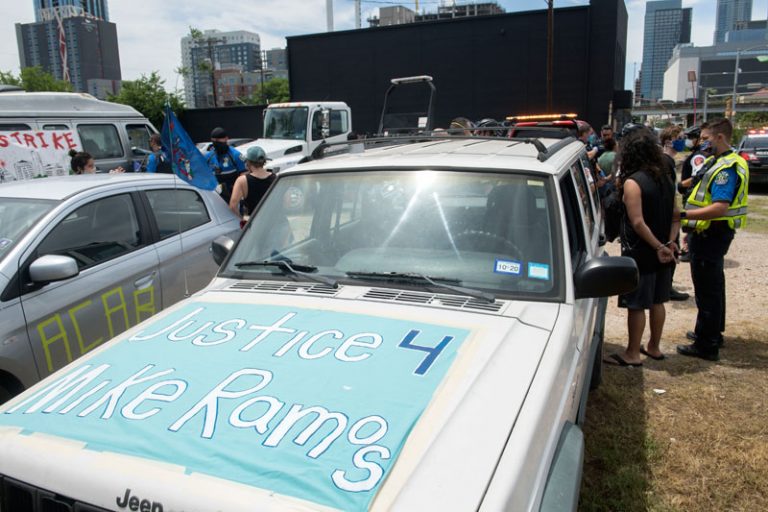
On May 1st, a host of factors converged to create the conditions for this action to launch into the public spotlight and maximize its efficacy. Of course, the day marks International Workers Day—a global holiday celebrated by the Left, workers, and autonomous struggles as a day to honor and advance forms of struggle and revolt. It also marked the second month of rent payments due during the pandemic, payments most tenants would not be able to make due to the concurrent economic crisis. This would be the second month where people would be faced with the looming threat of eviction, or the impossible to choice to forego food or medicine to pay their landlord. The Rent Strike ATX movement is only one piece of a globally unprecedented wave of tenant organizing to fight against the looming crisis of evictions on the horizon, all demanding the cancellation of rent and mortgages—demands which the political classes have overwhelmingly failed to heed.
On top of that, May 1st marked the first day of Governor Abbott’s plans to re-open the economy. Numbers from the day showed that as this occurred, the state experienced increasing numbers of COVID-19 cases and deaths. We now know, due to leaked audio, that Abbott himself acknowledged that his plans would exacerbate the pandemic, but judged the sacrifice of working people an acceptable cost for corporate profits and consumer comforts. Because of this, the city and the highway were the busiest they had been in weeks.
May 1st also marked a week since the murder of Mike Ramos by APD. Targeted for being a Black Latino man in a gentrifying sector of the city, Ramos’s execution was filmed and provoked outcry across the city. The shooting also came shortly after a third party report confirmed what many have known for years—that from top to bottom, APD is structurally racist. Demands for Justice for Mike Ramos were featured prominently in the caravan.
The combination of these factors made the May First rally well-timed to blast these issues and demands into a broader spotlight, applying pressure to the economy and politicians by intervening on the very day the economy was meant to move back towards normalcy. Across the country, other groups answered the call to become the shutdown—from labor strikes to mutual aid efforts to socially distanced protests. The Rent Strike ATX car demo landed in the crest of a series of compounding local, state-wide, and national moments that amplified its message and efficacy.
Continue the Experiment
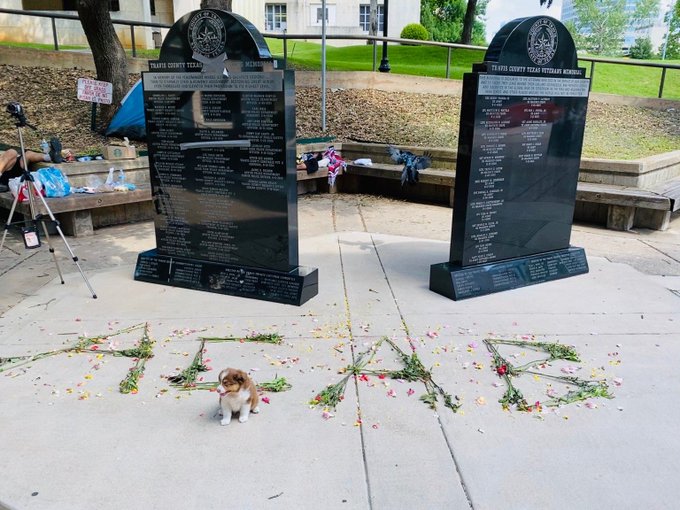
As outlined in the above sections, the car demonstration achieved a set of symbolic and materially strategic initiatives. It took over I-35 and, thanks in part to the police blockade, shut down the highway for at least an hour. Doing so without prior detection by the police, while still amassing a sizeable caravan of 30 cars, is a feat worth celebrating in itself, for it demonstrates the capacity of organized initiatives to outmaneuver forces of control. In retrospect, the uncontrolled nature of the demonstration made APD’s proclamation about their preparedness for May Day laughable.
In shifting away from the model of the car demo purely as noise demo, the action opened up new horizons for strategic uses of vehicles in protest in the city. Car demonstrations in recent weeks had targeted the Mayor’s condo, reflecting some of the innovations used in cities like LA where groups have brought the fight directly to the homes of decision-makers. This action, however, gestures towards other possibilities to target not just the decision-makers, but the very infrastructures in which power resides. One could imagine more demonstrations picking up on the wisdom of other car blockades, using vehicles to shut down shipping facilities in solidarity with striking workers, or surrounding prisons to demand freedom for all.
Based on the subsequent media coverage, the demonstration appears to have struck a good balance between materialist strategy and general legitimacy. The organizers, having crafted press releases in advance of the action and after the arrests, were able to garner significant media coverage, from local channels to the Associated Press. The coverage was overwhelmingly favorable, communicating many of the messages that the organizers themselves hoped to communicate—even the normally right wing tabloid The Daily Mail offered extremely generous coverage. This blasted the action into a national and even international spotlight. As of the writing of this article, the Daily Mail article alone garnered over 81,000 shares.
More than just media coverage, the protest garnered widespread public support and sympathy. The narrative crafted itself. Tenants and workers protesting for their survival were met with intense police repression, while armed right wing protestors violating social distancing to demand the reopening of the economy were completely legitimate in the eyes of the police. Not only were they unjustly policed, but they were met with a police force that was blatantly violating public health protocols by purposefully not wearing masks, ignoring social distancing, and jailing people in unsanitary conditions for offenses that could easily be ticket-able. Much of “the public” sided with the protestors, whom they saw as doing what they could to bring attention to a desperate issue, against the police, who came off as overwhelmingly cruel. The Rent Strike ATX fund, which had until this point received a few hundred dollars, exploded with thousands of dollars as people across the country donated to cover the costs of legal fees and impounded cars, which was widely recognized as another unreasonable burden to place on already struggling tenants.
It appears that it was neither just the protest’s secrecy in coordination nor its gestures towards public legitimacy that made it effective, but the combination of the two. Balancing the dual imperatives of operational & informational security and mass organizing, without collapsing either into paranoid and self-isolated radical cliques or populist movements wholly transparent to the forces of counterinsurgency, remains a question at the heart of autonomous activity. To have everyone “thoroughly confused as to whether we are frightening or loveable.”
Of course, celebrating an action does not mean being uncritical of its limitations or areas for improvement—as much can be learned from this action’s failures as its successes.
One of the clearest shortcomings was the failure to anticipate the police overreaction. One of the general limitations of the car demo form is that vehicles directly expose the identities of participants to the state and make them more easily penalized. Contrast this to pedestrian rallies that seized highways, where efforts such as masking could help anonymize participants. Arrest additionally impose burdens on movements and people. They suck time, energy, and money from efforts as cases get drawn out over time through the legal system—even if they eventually get dropped. The pending cases can also stymie future actions, as the threat of another arrest compounding the legal consequences faced by participants can discourage people from taking action until their cases are resolved.
It was clear that the organizers did not anticipate arrests—at worst, tickets. They did still gather basic info from most participants in case they would need legal support, but there was not a strong sense that arrest was the likely possibility. However, most people did not have a good idea of what the police response would be in the first place, since this was a new experiment. Legal observers were present, following along in cars in a similar experimentation in providing legal support for the car demo form. The lack of foresight caused some amount of confusion as organizers mobilized quickly to mobilize jail support, though the ad hoc efforts here were fairly impressive.
This is not to say that arrests are a sign of failure—as in this case, arrest often is hard to anticipate or avoid, and some actions are worth the risk they carry. In many ways, the arrests even gave momentum and legitimacy to Rent Strike ATX, boosted issues like the murder of Mike Ramos into a higher profile spotlight, and spurred further backlash against APD. Moments like this may even add to momentum which organizers can seize on in post-COVID city budget discussions, to direct any proposed austerity measures towards the de-funding of police departments. However, future experiments should continue to explore ways to maximize symbolic and strategic power while further minimizing the risks of arrest.
Additionally, the semi-public nature made it difficult for all participants to fully understand the plan and risks ahead of time. This made it difficult for people coming in to the action to honestly assess the level of risk they were undertaking which, combined with the organizers not expecting arrests, led to many being caught off guard. Because organizers had been relatively secretive about disclosing the full plan, out of fear of the information getting leaked to the police or reactionaries, the arrests and intensity of the action may have come as a shock to some of the participants. There is no clear answer to this dilemma. A fully secret action organized only through direct relations of trust could have more transparency, but may have produced limited numbers. On the flip-side, a more publicly transparent action may have been more easily preempted by the police or public backlash. This dilemma is only complicated by the remote, technologically-mediated nature of pandemic-era organizing, which renders virtually impossible the option of holding a no-tech meeting to discuss the upcoming action with folks.
One path out of this dilemma may involve a deepened commitment to mass organizing–a tenants organization with deep connection and shared strategic vision with a wide base of tenants across the city could easily and transparently mobilize its base to pull off an action like this. Additionally, it could do so operating from a base of trust with tenant organizers, allowing it to communicate largely through relatively secure communication mediums such as Signal, without having to publicize the event in advance in order to muster numbers. In doing so, all participants could go in knowing and committing to the risks of the action. This form of activity and the base that makes it possible, however, cannot be conjured in the weeks it takes to plan an action, but must be built patiently and diligently
The centralized nature of this type of car demonstration posed another limit to its power. In recent months, autonomous struggles have attempted to adopt the wisdom of the slogan “be water,” which reflects the use of a fluid strategy by Hong Kong rebels to outmaneuver police control in waging insurrection. By contrast, the crowding of all the cars on one stretch of highway, almost all of them marked with banners and signs, made it relatively easy for the police to identify and corral protestors. Without a predetermined plan to be more mobile and unpredictable once the highway was taken, and with traffic backing up behind them, the caravan was forced into a direct confrontation with the police. Additionally, the sheer number of cars appeared to itself be a logistical nightmare to coordinate, especially as they entered regular I-35 traffic, which caused the caravan to get somewhat dispersed and divided.
Future experiments may play with more mobile or geographically dispersed strategies. For example, highway demonstrations may alternate between slow rolling for stretches of highways and speeding up to avoid police response, or even exiting the highway and reappearing elsewhere. Other strategies may diverge from the mass caravan style, instead dividing into smaller mobile strike teams. A series of 5-10 cars staging demonstrations at different points on the highway, or at different strategic points throughout the city, could simultaneously have a bigger impact and more easily evade the police than a large group of 30 cars. These fluid efforts would further confuse the police response, splitting their resources, while maximizing the ability to stagger actions. Of course, the trade-off here is this would require more labor to coordinate the different groups of cars and to navigate multiple different areas, as opposed to mobilizing one group to target on area of the city.
These considerations beg the question of how well suited the car demo form is to the strategy of “be water.” While the car and the highway evoke an American imaginary of freedom and mobility, in reality the structure of highways and roadways, combined with the realities of urban gridlock, predictive traffic policing, and surveillance, make them into infrastructures of control. Highways in particular, while they are perhaps the post prominent economic targets, are also some of the riskiest and most difficult to seize—they carry large traffic volumes, have defined and easily controlled entry/exit points, and travel in one direction. Furthermore, cars themselves are clunky, ungraceful tools which lack the same ease of movement that an able-bodied rebel has in slipping through crowds, alleyways, and side streets to evade police control. Even with the above experimental forms, there is a limited range of motion that a group of cars can achieve on a busy road or when confronted with police. Even if one can evade physical capture, there remains the risk of the State using license plate, vehicle identification, and traffic surveillance systems to track down participants afterwards to slap charges, including potential evasion charges.
There could be many responses to this strategic obstacle. One may be to lean into the strategy of static, direct confrontation. For example, if the Rent Strike ATX caravan had known in advance that they would face arrest even if they complied with the order to exit the highway, they could have just called the police’s bluff and refused to move. This would force the police to make a scene of dragging people from their cars and carrying out arrests on the highway itself, and then compel them to figure out the logistics of towing all the cars, all the while continuing to render the highway inoperative. Or, the protestors could leave their cars parked on the highway and then exit on foot, where they could then maneuver through the rows of stalled cars and disperse. This strategy that may be more feasible if rented vehicles such as U-Hauls, rather than personal vehicles, were sacrificed for the action, and would still need to evade police cameras, cars, and bike cops to succeed. In either of these scenarios, organizers could attempt to publicize a call for others to converge and join in the defense of the blockade—a call which, if well answered, could open up an unpredictable opportunity for a mass takeover of the space. This brings both the excitement of opening up communized, insurrectionary space, and the problems of maintaining lines of support and supplies to sustain a consistent presence, or at least one strong enough to wait long enough to get the police to back down and let people leave freely.
On the other side of the spectrum, a more fluid strategy may forego targeting the highway itself and highlight other pressure points of the economy—distribution centers for companies like Amazon, transportation and administrative hubs for the carceral system, the data centers of surveillance capitalism, and more—that offer more possibilities for quick, distributed attack. These demonstrations could be coordinated to occur in rotations or quick succession; as the police converge on one demonstration, it disperses while another begins. Caravans could also mobilize flying blockades, moving to hit multiple targets and fleeing before being caught. Or, if the highway remains the target, they may coordinate to temporarily blockade exit ramps to cut off the paths by which the police would swoop in to intervene, buying time for the demonstration itself to move elsewhere to avoid direct confrontation.
These reflections and speculations are offered in addition to the essential takeaways offered from comrades in Atlanta—many of their preliminary lessons held up in this action and should be adopted by others experimenting with car demonstrations. As we enter a summer of uncertainty, caught between an intensifying pandemic and a sacrificial desire to restore politics and economics as usual, bold and strategic experiments shall become more and more essential. May the reflections and lessons from this context spread across territories and inspire those responding to our historic moment.
The future remains unwritten, and our actions shall write it.
